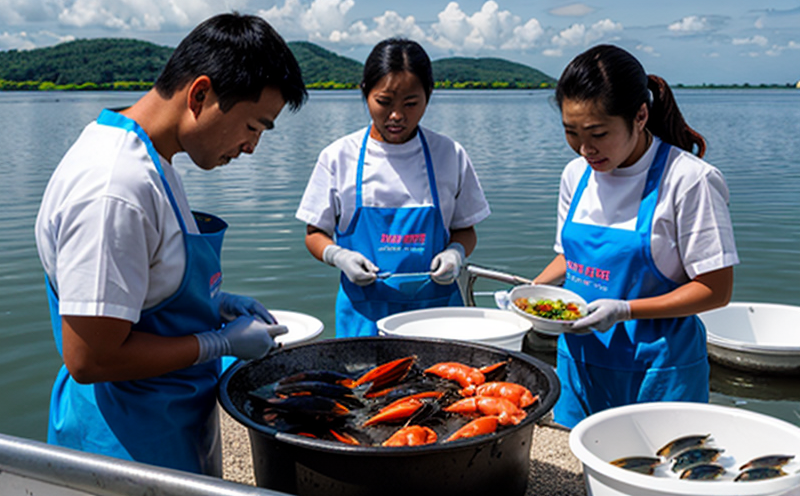ISO 10272 Campylobacter Testing in Shellfish
The presence of Campylobacter spp. is a critical concern for the food and feed industry, particularly within seafood and aquaculture sectors. Campylobacter jejuni and Campylobacter coli, among others, are known to cause severe gastrointestinal infections in humans through contaminated shellfish. The ISO 10272 standard provides a robust framework for the isolation, identification, and enumeration of these pathogens in shellfish samples.
This method is essential for ensuring food safety, maintaining consumer confidence, and meeting regulatory requirements such as those set by the FDA and the EFSA. The standard ensures that testing laboratories are equipped with the necessary protocols to detect even trace amounts of these pathogens. This service is vital for seafood processors, aquaculture operators, and regulatory bodies aiming to prevent contamination and maintain product integrity.
The ISO 10272 method involves several key steps: sample collection, preparation, inoculation, incubation, isolation, identification, and enumeration. The process begins with the selection of appropriate shellfish samples, which are then homogenized in a buffered peptone water (BPW) solution. The homogenate is then serially diluted and inoculated into Campy selective media to enhance the growth of Campylobacter spp.
The media used for this test includes CB, a medium specifically designed for the isolation of these organisms. After incubation, any colonies that appear are further identified using biochemical tests and PCR-based methods to confirm their identity as Campylobacter spp.
The method is particularly challenging due to the fastidious nature of Campylobacters. This necessitates a high degree of expertise in microbiology and stringent quality control measures to ensure accurate results. The test parameters are strictly defined within ISO 10272, ensuring consistency across different laboratories worldwide. Understanding these parameters is crucial for achieving reliable and reproducible results.
The standard also emphasizes the importance of proper specimen preparation techniques to avoid contamination or loss of viable cells. This includes careful handling during sample collection and rigorous aseptic technique during inoculation into selective media. Compliance with these procedures ensures that the test yields accurate results, which is critical for maintaining product safety and regulatory compliance.
The ISO 10272 method has been validated through extensive research and field studies, ensuring its reliability in real-world applications. It is widely used by quality managers, compliance officers, R&D engineers, and procurement professionals to ensure the safety of seafood products. By adhering to this standard, companies can demonstrate their commitment to food safety and regulatory compliance.
Applied Standards
| Standard Number | Description |
|---|---|
| ISO 10272-1 | General requirements for the enumeration of Campylobacter spp. in foodstuffs by means of the Campy selective medium. |
| ISO 10272-2 | Detection and confirmation of Campylobacter spp. in foodstuffs using PCR methods. |
| ISO 10272-3 | Enumeration of Campylobacter spp. in foodstuffs by means of the Campy selective medium and confirmation with biochemical tests. |
The ISO standards referenced above provide a comprehensive framework for the isolation, identification, and enumeration of Campylobacter spp. in shellfish. These standards are widely recognized as the gold standard in seafood safety testing and are essential for ensuring accurate and consistent results across different laboratories.
The use of these standards ensures that all testing is conducted under controlled conditions, which is crucial for obtaining reliable data. Compliance with ISO 10272-1 through -3 helps to maintain product integrity and ensure regulatory compliance. The standards also provide a framework for continuous improvement in laboratory practices, ensuring that the methods used are up-to-date and effective.
The implementation of these standards is particularly important in the context of global trade, where uniformity in testing protocols is essential. By adhering to ISO 10272, seafood processors and regulatory bodies can ensure that their products meet international safety standards and are acceptable for export. This not only enhances consumer confidence but also supports the growth of the seafood industry by reducing the risk of contamination.
Customer Impact and Satisfaction
- Ensures product safety, enhancing consumer trust in seafood products.
- Achieves regulatory compliance with FDA and EFSA standards.
- Supports global trade by ensuring uniform testing protocols across different regions.
- Maintains the integrity of seafood products, reducing the risk of contamination and spoilage.
- Provides accurate and consistent results through standardized methods.
The implementation of ISO 10272 Campylobacter Testing in Shellfish has a direct impact on customer satisfaction by ensuring that only safe and high-quality products reach the market. This service helps to protect public health, maintain brand reputation, and support sustainable seafood practices.
By adhering to this standard, customers can rest assured that their seafood products meet the highest safety standards. The results of this testing are crucial for quality managers, compliance officers, R&D engineers, and procurement professionals in making informed decisions about product safety and quality.
Competitive Advantage and Market Impact
The implementation of ISO 10272 Campylobacter Testing in Shellfish provides a significant competitive advantage by ensuring that seafood products meet the highest safety standards. This service helps companies to differentiate themselves from competitors by demonstrating their commitment to food safety and regulatory compliance.
By adhering to this standard, businesses can ensure that they are meeting or exceeding international safety standards, which is crucial for maintaining brand reputation and trust with customers. The results of this testing also provide valuable insights into the quality of seafood products, allowing companies to make informed decisions about product development and improvement.
The use of ISO 10272 Campylobacter Testing in Shellfish can also contribute to market growth by supporting sustainable seafood practices. By reducing the risk of contamination and spoilage, this service helps to maintain the integrity of seafood products, which is essential for long-term business success.
Furthermore, compliance with ISO 10272 Campylobacter Testing in Shellfish can provide a competitive edge in global markets where uniform testing protocols are required. This ensures that companies are meeting international safety standards and are acceptable for export, thereby opening up new opportunities for growth and expansion.





